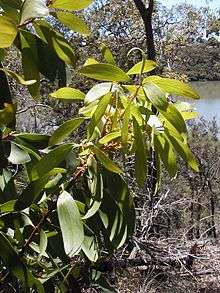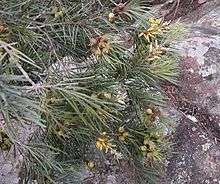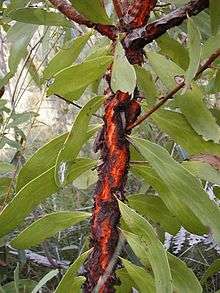Persoonia
| Persoonia | |
|---|---|
 | |
| Persoonia levis | |
| Scientific classification | |
| Kingdom: | Plantae |
| Clade: | Angiosperms |
| Clade: | Eudicots |
| Order: | Proteales |
| Family: | Proteaceae |
| Genus: | Persoonia Sm. |
| Type species | |
| Persoonia lanceolata | |
| Species | |
|
See text. | |
Persoonia is a genus of 98 species of shrubs and small trees in the subfamily Persoonioideae in the large and diverse plant family Proteaceae. In the eastern states of Australia, they are commonly known as geebungs, while in Western Australia and South Australia they go by the common name snottygobbles.[1] While their flowers are small and not prominent, persoonias are best known in the Australian bush for the striking bright green foliage of many species.
Taxonomy
The term geebung is derived from the Dharug language word geebung, while the Wiradjuri term was jibbong.[2]
The generic name is in honour of Dutch mycologist and botanist Christiaan Hendrik Persoon.
Unpublished data indicates Toronia, Garnieria and Acidonia all lie within the large genus Persoonia.[3]
Distribution and habitat
All species are endemic to Australia, though a closely related species, Toronia toru is found in New Zealand and has been described as a species within the genus Persoonia previously. They are widespread in non-arid regions. One species, P. pertinax, is found only in the Great Victoria Desert, while a few other species venture into the arid zone, but most are concentrated in the subtropical to temperate parts of south eastern and south western Australia, including Tasmania.
Most species are plants of well-drained, acid, sandy or sandstone-based soils that are low in nutrients, although one, Persoonia graminea, grows in swampy habitats. Three species (P. acicularis, P. bowgada and P. hexagona) tolerate mildly calcareous soils, and several south eastern species sometimes grow on basalt-derived soils, and but these are unusual. The greatest diversity of species is found in areas with soils derived from sandstones and granites.
Ecology
Interactions between micro-organisms and Persoonia species are poorly known, and no mycorrhizal associations have been reported for any species of Persoonioideae. Several species of Persoonia (P. elliptica, P. gunnii, P. longifolia, P. micranthera, P. muelleri) are known to be highly susceptible to infection by an Oomycete, Phytophthora cinnamomi, in the wild and this pathogen is strongly suspected of being responsible for the deaths of many other species in cultivation.
The sclerophyllous plant communities where Persoonia species usually live are fire-prone environments, hence Persoonia species have adapted to frequent bushfires. The most obvious adaptations are features that allow plants to survive fires, albeit in a more-or-less pruned state. Many species, especially in the south west, are lignotuberous, resprouting from ground level after fire. Several also develop thick bark that protects epicormic buds, which resprout from trunks and large branches after fire. The most eye-catching of these are the four “paper-barked” species: P. falcata, P. levis, P. linearis and P. longifolia. Branch resprouters with less conspicuous protective bark include P. amaliae, P. elliptica, P. katerae and P. stradbrokensis. Fire-sensitive species survive fires as buried seeds, which tend to germinate prolifically after disturbance. These species seem to require an interval of at least eight years between fires, allowing newly germinated plants to reach reproductive maturity and establish a replacement seed bank. The natural patterns and processes involved in this kind of life cycle, including seed longevity, the environmental cues that stimulate germination, and even the time from germination to first flowering are still poorly understood.
The best studied interaction between animals and Persoonia species is that between the plants and their pollinators. All species that have been studied in detail have been found to be pollinated by a variety of native bees, but especially species of Leioproctus subgenus Cladocerapis (Colletidae), which rarely visit any plants but Persoonia. The behaviour of these bees on Persoonia flowers is quite predictable. Both males and females alight on the cross-shaped “platform” formed by the recurved anther tips, orient themselves to be facing one of the anther/tepals, then slide, face first, down between the anther and the style to reach the two glands at either side of the base of the tepal, and drink the nectar from them. Females gather pollen grains with their legs while drinking nectar. The insect then withdraws to the top of the flower, makes a 180° turn, then repeats the process on the other side of the flower. Another species group in Leioproctus, subgenus Filiglossa, also specialises in feeding on Persoonia flowers but these smaller bees seem to be nectar and pollen “thieves”, not effective pollinators. The introduced honeybee (Apis mellifera) is also a frequent visitor of Persoonia flowers at most sites but it is still unclear whether this species is an effective pollinator. The fleshy fruits of Persoonia species are clearly adapted for animal dispersal but it is still unclear whether mammals such as possums and wallabies, or large flying birds such as currawongs are the most important dispersers. Parrots, also feed on Persoonia fruits, but the fruit (and seed) they eat are unripe, and hence their interaction with the plants is predatory rather than symbiotic.
Species



References
- ↑ Bernhardt, Peter (2002). The Rose's Kiss: A Natural History of Flowers. University of Chicago Press. p. 118. Retrieved 1 November 2015.
- ↑ Australian National Botanic Gardens (2007). "Aboriginal Plant Use - NSW Southern Tablelands: Geebung". Canberra, Australian Capital Territory: Department of the Environment and Heritage. Retrieved 5 November 2011.
- ↑ Weston, Peter H.; Barker, Nigel P. (2006). "A new suprageneric classification of the Proteaceae, with an annotated checklist of genera" (PDF). Telopea. 11 (3): 314–344.
Further reading
- Bernhardt, P.; Weston, P. H. (1996). "The pollination ecology of Persoonia (Proteaceae) in eastern Australia". Telopea. 6: 775–804.
- Maynard, G. V. (1995). "Pollinators of Australian Proteaceae". In McCarthy, Patrick. Flora of Australia: Volume 16: Eleagnaceae, Proteaceae 1. CSIRO Publishing / Australian Biological Resources Study. pp. 30–33. ISBN 0-643-05693-9.
- Weston, P. H. (1995). "Persoonioideae". In McCarthy, Patrick. Flora of Australia: Volume 16: Eleagnaceae, Proteaceae 1. CSIRO Publishing / Australian Biological Resources Study. pp. 47–125. ISBN 0-643-05693-9.
- Weston, Peter H. (2003). "Proteaceae subfamily Persoonioideae". Australian Plants. 22 (175): 62–78. ISSN 0005-0008.